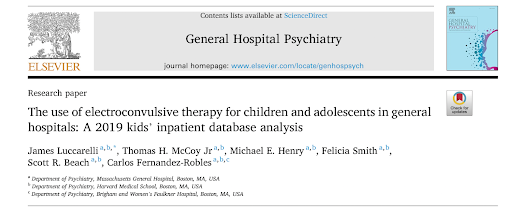Pediatric ECT in the USA: Data From the KID Database
Out on PubMed, from the harvard group, is this study:
The use of electroconvulsive therapy for children and adolescents in general hospitals: A 2019 kids' inpatient database analysis.
Gen Hosp Psychiatry. 2023 Mar 26;82:95-100. doi: 10.1016/j.genhosppsych.2023.03.012. Online ahead of print.PMID: 370044
The abstract is copied below:
Objective:
Objective:Electroconvulsive therapy (ECT) devices are classified as class II (moderate risk) for the treatment of depressive disorders and catatonia in patients aged 13 and older, but it is unknown how often the treatment is utilized by child and adolescent patients. The aim of this study was to examine the demographics of child and adolescent hospitalizations involving ECT, the medical and psychiatric comorbidities of these hospitalizations, and the overall number of treatments administered per hospitalization.
Method: The 2019 Kids' Inpatient Database, a national sample of pediatric discharges from 3998 acute care hospitals, was analyzed for hospitalizations involving patients aged 19 and younger receiving ECT based on inpatient procedural codes.
Results: 315 (95% confidence interval 275 to 354) discharges among child and adolescent patients, or 0.03% of youth hospitalizations, involved the administration of ECT in the KID in 2019. Hospitalizations in the Northeast, those involving patients residing in ZIP codes in the top income quartile, and those for commercially insured patients had higher odds of ECT administration. Primary discharge diagnoses among ECT recipients were major depressive disorder (143; 46.4%), schizophrenia and other psychotic disorders (71; 23.1%) and bipolar disorder (59; 19.2%). In total 153 (48.6%) of ECT recipients had a coded diagnosis of suicidal ideation. Hospitalizations involved a median of 2 (IQR 1 to 5) ECT treatments before discharge.
Conclusions: ECT is rarely utilized in the inpatient treatment of child and adolescent patients, but is most often administered to patients with mood and psychotic disorders. Commercial insurance and higher income were associated with higher odds of ECT administration, suggesting that access to care may be limited.
Keywords: Adolescent psychiatry; Cohort studies; Depressive disorders; Electroconvulsive therapy; Real world evidence.
The article is here.
And from the text:

Kudos to James Luccarelli for mining this database so fruitfully!






Comments
Post a Comment